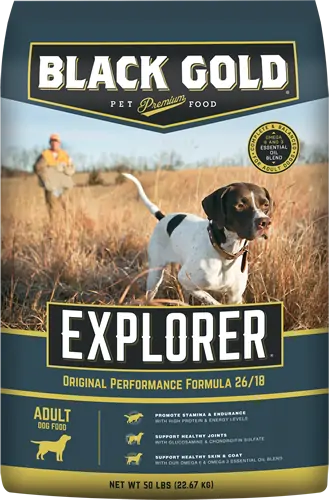
DogFoodAdvisor is reader supported See how
All reviews are 100% impartial but if you buy using links on this page, we may earn a referral fee.
Our Verdict
Black Gold Explorer Dog Food receives the Advisor’s top rating of 5 stars.
The Black Gold Explorer product line includes the 9 dry dog foods listed below.
Each recipe includes its AAFCO nutrient profile: Growth (puppy), Maintenance (adult), All Life Stages, Supplemental or Unspecified.
| Product line | Rating | AAFCO |
|---|---|---|
| Black Gold Explorer Mature 7+ Recipe | 5 | M |
| Black Gold Explorer Puppy Recipe | 5 | A |
| Black Gold Explorer Chicken Meal and Brown Rice Recipe | 5 | M |
| Black Gold Explorer Original Performance Formula 26/18 | 4.5 | M |
| Black Gold Explorer Beef Meal and Barley Recipe | 4.5 | M |
| Black Gold Explorer Sensitive Skin and Coat Ocean Fish Meal and Oat Recipe | 4.5 | M |
| Black Gold Explorer Super Performance Formula 32/21 | 5 | A |
| Black Gold Explorer Large Breed Puppy Recipe | 5 | A |
| Black Gold Explorer Large Breed Adult Recipe | 4 | A |
Recipe and Label Analysis
Black Gold Explorer Original Performance Formula 26/18 was selected to represent the other products in the line for detailed recipe and nutrient analysis.
Black Gold Explorer Original Performance Formula
Estimated Dry Matter Nutrient Content
Protein
Fat
CarbsCarbohydrates
Beef meal, ground corn, ground wheat, corn gluten meal, chicken fat (preserved with mixed tocopherols), chicken by-product meal (source of glucosamine and chondroitin sulfate), dried plain beet pulp, brown rice, natural flavors, flaxseed, potassium chloride, salt, vitamins (vitamin E supplement, niacin supplement, d-calcium pantothenate, riboflavin supplement, vitamin A supplement, vitamin D3 supplement, vitamin B12 supplement, pyridoxine hydrochloride, biotin, thiamine mononitrate, folic acid), minerals (ferrous sulfate, zinc sulfate, copper sulfate, calcium iodate, manganese sulfate, sodium selenite), taurine, choline chloride, inulin, yeast culture, dried Enterococcus faecium fermentation product, dried Lactobacillus acidophilus fermentation product, dried Aspergillus niger fermentation extract, dried Trichoderma longibrachiatum fermentation product, dried Bacillus subtilis fermentation product, rosemary extract
Fiber (estimated dry matter content) = 3%
Red denotes any controversial items
| Estimated Nutrient Content | |||
|---|---|---|---|
| Method | Protein | Fat | Carbs |
| Guaranteed Analysis | 26% | 18% | NA |
| Dry Matter Basis | 29% | 20% | 43% |
| Calorie Weighted Basis | 24% | 40% | 36% |
Ingredients Analysis
The first ingredient in this dog food is beef meal. Beef meal is considered a meat concentrate and contains nearly 300% more protein than fresh beef.
The second ingredient is corn. Corn is an inexpensive and controversial cereal grain. And aside from its energy content, this grain is of only modest nutritional value to a dog.
The third ingredient is wheat. Wheat is another cereal grain and subject to the same issues as corn (previously discussed).
The fourth ingredient is corn gluten meal. Gluten is the rubbery residue remaining once corn has had most of its starchy carbohydrate washed out of it.
Although corn gluten meal contains 60% protein, this ingredient would be expected to have a lower biological value than meat.
And less costly plant-based products like this can notably boost the total protein reported on the label — a factor that must be considered when judging the actual meat content of this dog food.
The fifth ingredient is chicken fat. This item is obtained from rendering chicken, a process similar to making soup in which the fat itself is skimmed from the surface of the liquid.
Chicken fat is high in linoleic acid, an omega-6 fatty acid essential for life. Although it doesn’t sound very appetizing, chicken fat is actually a quality ingredient.
The sixth ingredient is chicken by-product meal, another protein-rich meat concentrate.
Chicken by-product meal is a dry rendered product of slaughterhouse waste. It’s made from what’s left of a slaughtered chicken after all the choice cuts have been removed.
On the brighter side, by-product meals are meat concentrates and contain nearly 300% more protein than fresh chicken.
The quality of this ingredient can vary, depending on the caliber of the raw materials obtained by the manufacturer.
The seventh ingredient is beet pulp. Beet pulp is a controversial ingredient, a high fiber by-product of sugar beet processing.
Some denounce beet pulp as an inexpensive filler while others cite its outstanding intestinal health and blood sugar benefits.
We only call your attention here to the controversy and believe the inclusion of beet pulp in reasonable amounts in most dog foods is entirely acceptable.
The eighth ingredient is brown rice, a complex carbohydrate that (once cooked) can be fairly easy to digest. However, aside from its natural energy content, rice is of only modest nutritional value to a dog.
After the natural flavors, we find flaxseed, one of the best plant sources of healthy omega-3 fatty acids. Provided they’ve first been ground into a meal, flax seeds are also rich in soluble fiber.
However, flaxseed contains about 19% protein, a factor that must be considered when judging the actual meat content of this dog food.
From here, the list goes on to include a number of other items.
But to be realistic, ingredients located this far down the list (other than nutritional supplements) are not likely to affect the overall rating of this product.
With 4 notable exceptions…
First, the minerals listed here do not appear to be chelated. And that can make them more difficult to absorb. Chelated minerals are usually associated with higher quality dog foods.
Next, chicory root is rich in inulin, a starch-like compound made up of repeating units of carbohydrates and found in certain roots and tubers.
Not only is inulin a natural source of soluble dietary fiber, it’s also a prebiotic used to promote the growth of healthy bacteria in a dog’s digestive tract.
In addition, this recipe contains sodium selenite, a controversial form of the mineral selenium. Sodium selenite appears to be nutritionally inferior to the more natural source of selenium found in selenium yeast.
And lastly, we note the use of taurine, an important amino acid associated with the healthy function of heart muscle. Although taurine is not typically considered essential in canines, some dogs have been shown to be deficient in this critical nutrient.
Since taurine deficiency appears to be more common in pets consuming grain-free diets, we view its presence in this recipe as a positive addition.
Nutrient Analysis
Based on its ingredients alone, Black Gold Explorer Dog Food looks like an average dry product.
The dashboard displays a dry matter protein reading of 29%, a fat level of 20% and estimated carbohydrates of about 43%.
As a group, the brand features an average protein content of 30% and a mean fat level of 18%. Together, these figures suggest a carbohydrate content of 45% for the overall product line.
And a fat-to-protein ratio of about 59%.
Above-average protein. Above-average fat. And below-average carbs when compared to a typical dry dog food.
When you consider the protein-boosting effect of the corn gluten meal and flaxseed, this still looks like the profile of a kibble containing an above-average amount of meat.
However, with 40% of the total calories in our example coming from fat versus just 24% from protein, some recipes may not be suitable for animals on a low fat diet.
Black Gold Dog Food Recall History
The following automated list (if present) includes all dog food recalls related to Black Gold through April 2025.
No recalls noted.
You can view a complete list of all dog food recalls since 2009 here.
Our Rating of Black Gold Grain Inclusive Dog Food
Black Gold Explorer is a grain-inclusive dry dog food using a significant amount of named meat meals as its dominant source of animal protein, thus earning the brand 5 stars.
Compare Black Gold Dog Food
How does Black Gold compare with The Dog Food Advisor's most recommended brands?
A Final Word
The Dog Food Advisor does not accept money, gifts, samples or other incentives in exchange for special consideration in preparing our reviews.
However, we do receive a referral fee from online retailers (like Chewy or Amazon) and from sellers of perishable pet food when readers click over to their websites from ours. This helps cover the cost of operation of our free blog. Thanks for your support.
For more information, please visit our Disclaimer and Disclosure page.







